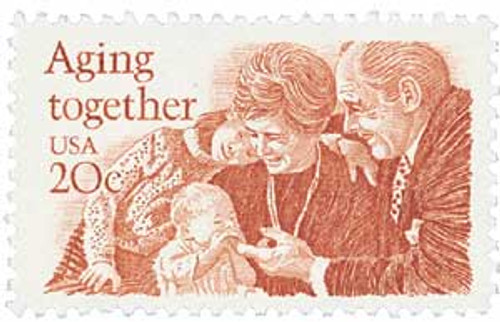
# 2011 - 1982 20c Aging Together
U.S. #2011
1982 20¢ Aging Together
- Issued to raise awareness of what older Americans contribute to society
- Also issued as part of Older Americans Month
Stamp Category: Commemorative
Value: 20¢, first-class rate
First Day of Issue: May 21, 1982
First Day City: Sun City, Arizona
Quantity Issued: 173,160,000
Printed by: Bureau of Engraving and Printing
Printing Method: Engraved
Format: Panes of 50 in sheets of 200
Perforations: 11
Color: Brown
Why the stamp was issued: Issued in May 1982, during “Older Americans Month,” this stamp honors our older citizens and recognizes them as highly valued Americans who have enriched society with their wealth of experience.
About the stamp design: Long-time stamp designer Paul Calle created the image for this stamp depicting a pair of grandparents holding a baby with a young girl resting on the grandmother’s shoulder. Calle didn’t receive specific instructions for the stamp design, simply the title, denomination, and size. He went through his large collection of photographs and created composites for each of the figures pictured on the stamp.
When the USPS unveiled the stamp design at the White House Conference on Aging in December 1981, the assistant postmaster general said, “It is a truly warm and meaningful design, communicating love and caring and dignity between the generations.” He went on to say that he hoped “the stamp will remind all Americans of the work that remains to be done to make aging in America not a tragedy, but a triumph of human will and achievement.”
First Day City: The First Day ceremony for this stamp was held at Sun City, a large retirement community near Phoenix, Arizona.
History the stamp represents: On May 1, 1963, the US observed its first Senior Citizens Month, later renamed Older Americans Month. Since its inception, it has been a time to raise awareness of issues facing older Americans as well as honor their contributions to our nation.
The US had created some programs aimed at older Americans in the decades prior – including the Civil Service Retirement Act (1920), the Social Security Act (1935), and the Railroad Retirement Act (1937). Then in 1950, President Harry Truman called for a report on the problems plaguing the country’s “increasingly older population.” This led to the first National Conference on Aging that year. The Special Staff on Aging was established in 1956, as well as the Federal Council on Aging. The White House hosted its first Conference on Aging in 1961 and Congress established a permanent Commission on Aging in 1962.
In early 1963, President John F. Kennedy met with the National Council of Senior Citizens. They discussed their concerns over the fact that many older Americans were living in poverty and there weren’t many programs available to help them. Together they developed a plan to establish Senior Citizens Month. Kennedy issued an official proclamation on April 18, designating May 1963 as Senior Citizens Month.
In his proclamation, Kennedy acknowledged the important role of older Americans, whose skills, wisdom, and experience helped build our nation and continue to provide leadership and counsel. He went on to say that as Americans reach their later years, they should be able to enjoy the full benefits of advances in wealth, science, technology, and culture. Kennedy urged Americans to use Senior Citizens Month as a time to raise awareness of the problems they faced and search for new opportunities and services to best address their needs.
Two years later, Kennedy’s successor, Lyndon B. Johnson, signed the Older Americans Act into law on July 14, 1965. The act formally established May as Older Americans Month and took further steps to help America’s seniors. It created the Department of Health, Education and Welfare’s Administration on Aging, which would oversee grant programs and other government activities for older Americans. The act also encouraged states to form their own State Units on Aging and provided grants to the states to support social services, projects, and training in the field of aging.
The 1965 Older Americans Act helped create new nutrition programs, transportation help, federally-backed adult day care, legal services, and more for seniors. It also led to the addition of Medicare, Title XVIII, specifically for the elderly, as well as Medicare, Title XIX, for low-income Americans, to the Social Security Act.
The Older Americans Act was extended for another two years in 1967 and established a study for the Administration on Aging to explore new needs for their field. The Age Discrimination Act was also signed into law that year. The 1970s saw the Second White House Conference on Aging in 1971 and the creation of a national nutrition program for the elderly in 1972. In 1973, the Older Americans Comprehensive Services Amendments set up Area Agencies on Aging, providing funds for local agencies to create senior centers and an employment grant program for low-income seniors. Additional grants were created in 1974 to provide protective, homemaker, transportation, and training services. The National Institute on Aging was also created that year, to study the aging process. The Older Americans Act was reauthorized several more times over the years, adding additional programs and aid as needed.
Additionally, every president since Johnson has issued a formal proclamation for Older Americans Month in May. These proclamations encourage people across America to use this time to remember and honor older Americans. Local groups stage events, fairs, and fundraisers celebrating older Americans. And for many years, the Administration on Aging and the Administration of Community Living have assigned different themes for each celebration. Some of these past themes have included “Living Longer, Growing Stronger in America,” “Honor the Past, Imagine the Future: Towards a Society for All Ages,” “Aging Well, Living Well,” “Safe Today. Healthy Tomorrow,” and “Engage at Every Age.”
U.S. #2011
1982 20¢ Aging Together
- Issued to raise awareness of what older Americans contribute to society
- Also issued as part of Older Americans Month
Stamp Category: Commemorative
Value: 20¢, first-class rate
First Day of Issue: May 21, 1982
First Day City: Sun City, Arizona
Quantity Issued: 173,160,000
Printed by: Bureau of Engraving and Printing
Printing Method: Engraved
Format: Panes of 50 in sheets of 200
Perforations: 11
Color: Brown
Why the stamp was issued: Issued in May 1982, during “Older Americans Month,” this stamp honors our older citizens and recognizes them as highly valued Americans who have enriched society with their wealth of experience.
About the stamp design: Long-time stamp designer Paul Calle created the image for this stamp depicting a pair of grandparents holding a baby with a young girl resting on the grandmother’s shoulder. Calle didn’t receive specific instructions for the stamp design, simply the title, denomination, and size. He went through his large collection of photographs and created composites for each of the figures pictured on the stamp.
When the USPS unveiled the stamp design at the White House Conference on Aging in December 1981, the assistant postmaster general said, “It is a truly warm and meaningful design, communicating love and caring and dignity between the generations.” He went on to say that he hoped “the stamp will remind all Americans of the work that remains to be done to make aging in America not a tragedy, but a triumph of human will and achievement.”
First Day City: The First Day ceremony for this stamp was held at Sun City, a large retirement community near Phoenix, Arizona.
History the stamp represents: On May 1, 1963, the US observed its first Senior Citizens Month, later renamed Older Americans Month. Since its inception, it has been a time to raise awareness of issues facing older Americans as well as honor their contributions to our nation.
The US had created some programs aimed at older Americans in the decades prior – including the Civil Service Retirement Act (1920), the Social Security Act (1935), and the Railroad Retirement Act (1937). Then in 1950, President Harry Truman called for a report on the problems plaguing the country’s “increasingly older population.” This led to the first National Conference on Aging that year. The Special Staff on Aging was established in 1956, as well as the Federal Council on Aging. The White House hosted its first Conference on Aging in 1961 and Congress established a permanent Commission on Aging in 1962.
In early 1963, President John F. Kennedy met with the National Council of Senior Citizens. They discussed their concerns over the fact that many older Americans were living in poverty and there weren’t many programs available to help them. Together they developed a plan to establish Senior Citizens Month. Kennedy issued an official proclamation on April 18, designating May 1963 as Senior Citizens Month.
In his proclamation, Kennedy acknowledged the important role of older Americans, whose skills, wisdom, and experience helped build our nation and continue to provide leadership and counsel. He went on to say that as Americans reach their later years, they should be able to enjoy the full benefits of advances in wealth, science, technology, and culture. Kennedy urged Americans to use Senior Citizens Month as a time to raise awareness of the problems they faced and search for new opportunities and services to best address their needs.
Two years later, Kennedy’s successor, Lyndon B. Johnson, signed the Older Americans Act into law on July 14, 1965. The act formally established May as Older Americans Month and took further steps to help America’s seniors. It created the Department of Health, Education and Welfare’s Administration on Aging, which would oversee grant programs and other government activities for older Americans. The act also encouraged states to form their own State Units on Aging and provided grants to the states to support social services, projects, and training in the field of aging.
The 1965 Older Americans Act helped create new nutrition programs, transportation help, federally-backed adult day care, legal services, and more for seniors. It also led to the addition of Medicare, Title XVIII, specifically for the elderly, as well as Medicare, Title XIX, for low-income Americans, to the Social Security Act.
The Older Americans Act was extended for another two years in 1967 and established a study for the Administration on Aging to explore new needs for their field. The Age Discrimination Act was also signed into law that year. The 1970s saw the Second White House Conference on Aging in 1971 and the creation of a national nutrition program for the elderly in 1972. In 1973, the Older Americans Comprehensive Services Amendments set up Area Agencies on Aging, providing funds for local agencies to create senior centers and an employment grant program for low-income seniors. Additional grants were created in 1974 to provide protective, homemaker, transportation, and training services. The National Institute on Aging was also created that year, to study the aging process. The Older Americans Act was reauthorized several more times over the years, adding additional programs and aid as needed.
Additionally, every president since Johnson has issued a formal proclamation for Older Americans Month in May. These proclamations encourage people across America to use this time to remember and honor older Americans. Local groups stage events, fairs, and fundraisers celebrating older Americans. And for many years, the Administration on Aging and the Administration of Community Living have assigned different themes for each celebration. Some of these past themes have included “Living Longer, Growing Stronger in America,” “Honor the Past, Imagine the Future: Towards a Society for All Ages,” “Aging Well, Living Well,” “Safe Today. Healthy Tomorrow,” and “Engage at Every Age.”










